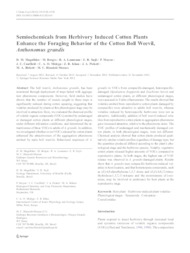Semiochemicals from herbivory induced cotton plants enhance the foraging behavior of the cotton boll weevil, Anthonomus grandis.
Semiochemicals from herbivory induced cotton plants enhance the foraging behavior of the cotton boll weevil, Anthonomus grandis.
Author(s): MAGALHÃES, D. M.; BORGES, M.; LAUMANN, R. A.; SUJII, E. R.; MAYON, P.; CAULFIELD, J. C; MIDEGA, C. A. O.; KHAN, Z. R.; PICKETT, P. J. A.; BIRKETT, M. A.; MORAES, M. C. B.
Summary: The boll weevil, Anthonomus grandis, has been monitored through deployment of traps baited with aggregation pheromone components. However, field studies have shown that the number of insects caught in these traps is significantly reduced during cotton squaring, suggesting that volatiles produced by plants at this phenological stage may be involved in attraction. Here, we evaluated the chemical profile of volatile organic compounds (VOCs) emitted by undamaged or damaged cotton plants at different phenological stages, under different infestation conditions, and determined the attractiveness of these VOCs to adults of A. grandis. In addition, we investigated whether or not VOCs released by cotton plants enhanced the attractiveness of the aggregation pheromone emitted by male boll weevils. Behavioral responses of A. grandis to VOCs from conspecific-damaged, heterospecificdamaged (Spodoptera frugiperda and Euschistus heros) and undamaged cotton plants, at different phenological stages, were assessed in Y-tube olfactometers. The results showed that volatiles emitted from reproductive cotton plants damaged by conspecifics were attractive to adults boll weevils, whereas volatiles induced by heterospecific herbivores were not as attractive. Additionally, addition of boll weevil-induced volatiles fromreproductive cotton plants to aggregation pheromone gave increased attraction, relative to the pheromone alone. The VOC profiles of undamaged and mechanically damaged cotton plants, in both phenological stages, were not different. Chemical analysis showed that cotton plants produced qualitatively similar volatile profiles regardless of damage type, but the quantities produced differed according to the plant?s phenological stage and the herbivore species. Notably, vegetative cotton plants released higher amounts of VOCs compared to reproductive plants. At both stages, the highest rate of VOC release was observed in A. grandis-damaged plants. Results show that A. grandis uses conspecific herbivore-induced volatiles in host location, and that homoterpene compounds, such as (E)-4,8-dimethylnona-1,3,7?triene and (E,E)-4,8,12-trime-thyltrideca-1,3,7,11-tetraene and the monoterpene (E)-ocimene, may be involved in preference for host plants at the reproductive stage.
Publication year: 2012
Types of publication: Journal article
Observation
Some of Embrapa's publications are published as ePub files. To read them, use or download one of the following free software options to your computer or mobile device. Android: Google Play Books; IOS: iBooks; Windows and Linux: Calibre.
Access other publications
Access the Agricultural Research Database (BDPA) to consult Embrapa's full library collection and records.
Visit Embrapa Bookstore to purchase books and other publications sold by Embrapa.

